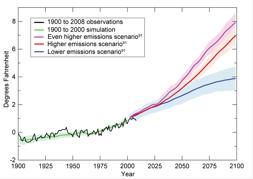Climate Change

Temperate forests have a unique role with respect to projected climate change in terms of the potential to provide additional mitigation through the combined benefits of greater net in-forest carbon storage, carbon storage in wood products, and direct and indirect substitution benefits from reduced fossil fuel use ( Managing Forests because Carbon Matters JOF Supplement , Stewart_Nakamura_FPJ2012_FullGHG_Accounting ) . California’s forests have been adding carbon inventory for decades but future trends can be altered by natural disturbances as well as proactive management decisions. Choosing to plant seedlings for future rather than historic climates as well as managing forests to address changing social demands (e.g. - water runoff for hydroelectric power and downstream users may become more important) are examples of possible mitigation strategies.
Resources:
The 25th UCCE publication in the Forest Stewardship Series was published in 2017 and is on Adapting forests to climate change .
CalFire's FRAP 2010 assessment has a chapter on climate change threats and opportunities .
The US Forest Service's report on California Forest Resources, 2001-2010 contains information on climate change.
The 2009 report of the US Global Change Research Program has data and projections at the regional level. Look at both the Southwest and Northwest regions for information relevant to California forests.
The Climate, Forests and Woodlands site on the extension.org web site contains a large number of short articles with references on forest ecosystems, climate change, climate-forest interactions, and adaptation strategies.
The Society of American Foresters has released a supplemental issue titled Managing Forests because Managing Forests because Carbon Matters-Integrating Energy, Products and Land Management Policy in October 2011.
Websites:
Use keywords such as forests and woodlands as these web sites often contain new reports
